The future of cytokine detection is bound to be a red sea. You should know about these clinical applications.
Foreword:
In our bodies, there is a mysterious and powerful system, which always protects us from external pathogens. This system is our immune system, which is composed of many immune cells, like a well-trained army, always ready to resist foreign enemies. In this army, there is a mysterious force playing a role silently, which is cytokine.
Overview of cytokines
Cytokines are a kind of small molecular protein with wide biological activity, which is synthesized and secreted by immune cells (such as monocytes, macrophages, T cells, B cells, NK cells, etc.) and some non-immune cells (such as endothelial cells, epidermal cells, fibroblasts, etc.), and is equivalent to the "messenger" of mutual communication among various cells in human body.
It has many biological functions, such as regulating cell growth, differentiation and maturation, maintaining function, regulating immune response, participating in inflammatory reaction, wound healing and tumor growth and decline.
At present, the detection of cytokines is widely used in infections, kidney diseases, autoimmune diseases, tumors and malignant hematological diseases, which has important clinical significance in the diagnosis of diseases, the judgment of treatment opportunity, the guidance of medication, the monitoring of curative effect, the early warning of cytokine storm risk and the improvement of patients’ treatment efficiency.
Classification and main functions of cytokines
According to their main functions, cytokines can be divided into the following categories: interleukin (ILs), colony stimulating factor (CSFs), interferon (IFNs), tumor necrosis factor (TNFs), growth factor (GFs) and chemokine (CK).
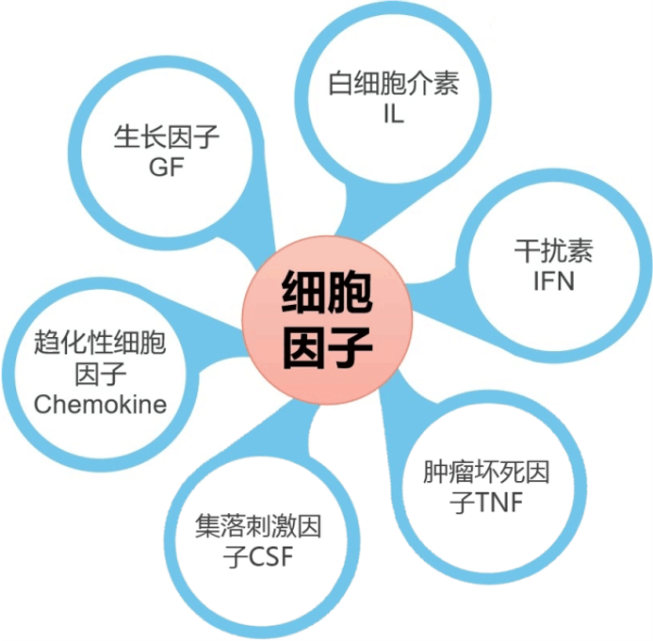
There are both pro-inflammatory factors and anti-inflammatory factors. Pro-inflammatory factors usually regulate the growth, activation, differentiation and homing of immune cells to infected sites, aiming at controlling and eradicating intracellular pathogens (including viruses); Anti-inflammatory cytokines are a series of immunomodulatory molecules that control the response of pro-inflammatory cytokines.
In the development of infection, the interaction between pro-inflammatory factors and anti-inflammatory factors runs through, which has a far-reaching impact on the development direction and outcome of infection.
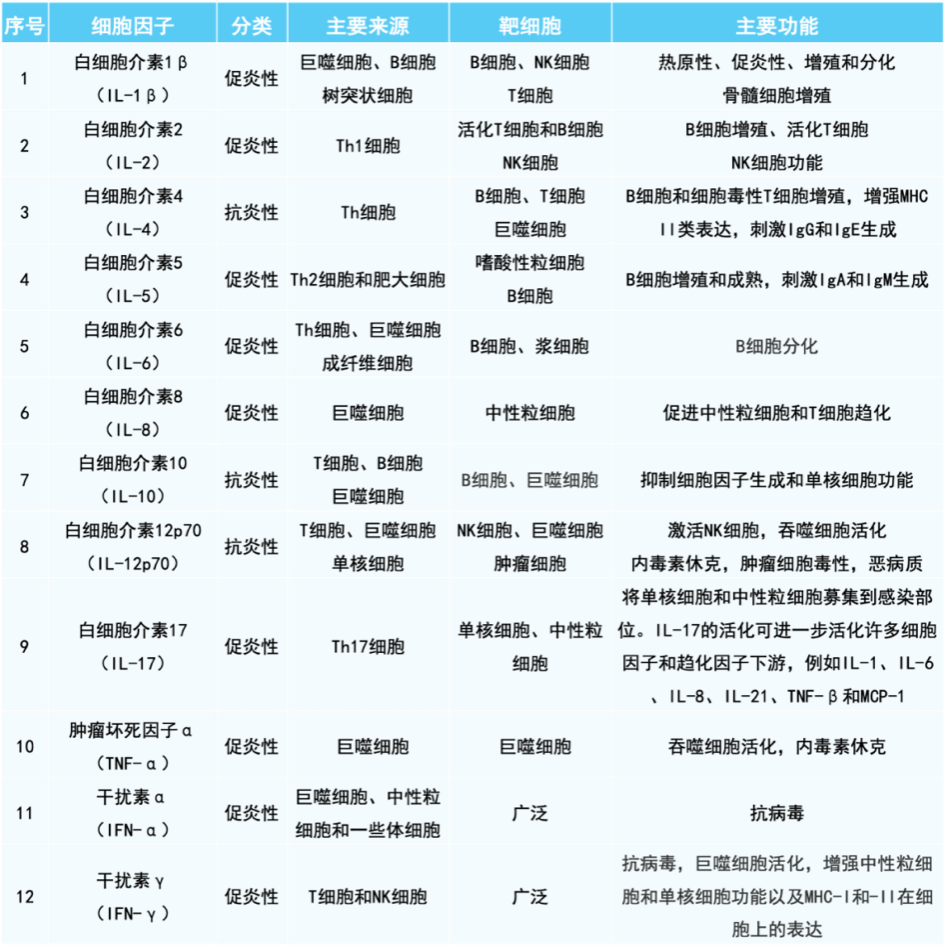
Clinical application value of cytokines
1, early diagnosis of infection, conducive to disease monitoring.
Shortening the window period helps to realize early diagnosis and win valuable time for treatment; The half-life is short, which is convenient to monitor the efficacy in time and ensure the effectiveness and safety of treatment; Complement with PCT and CRP, improve the accuracy of diagnosis and provide strong support for precise treatment.
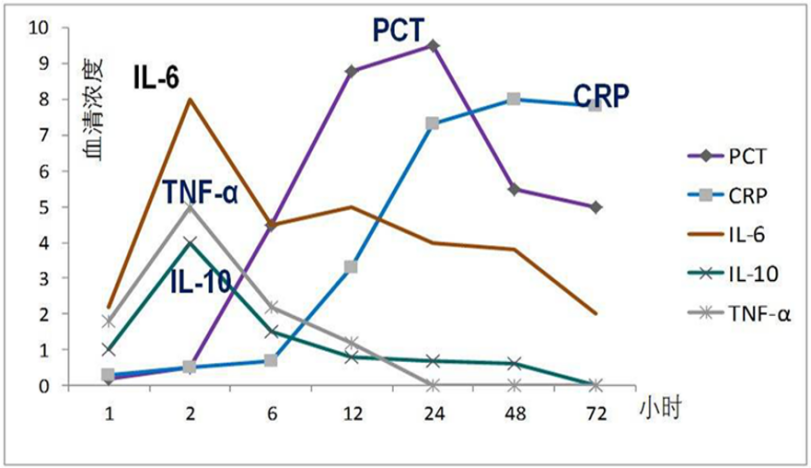
Note: In the Expert Consensus on Interpretation of Clinical Significance of Infection-related Biomarkers published in 2017, IL-6 has been regarded as one of the infection-related biomarkers.
2, help to determine the type of infection.
A study showed that IL-6 and IL-10 increased more than 10 times at the same time, suggesting G- bacteria infection; IL-6 increased by 2 times, and IL-10 increased by less than 10 times, suggesting G+ bacteria infection. According to the cytokine spectrum, the effective rate of identifying Gram bacteria to guide antibiotic treatment is close to that of broad-spectrum coverage group, up to 85%, while the effective rate of empirical treatment group is only 60%.
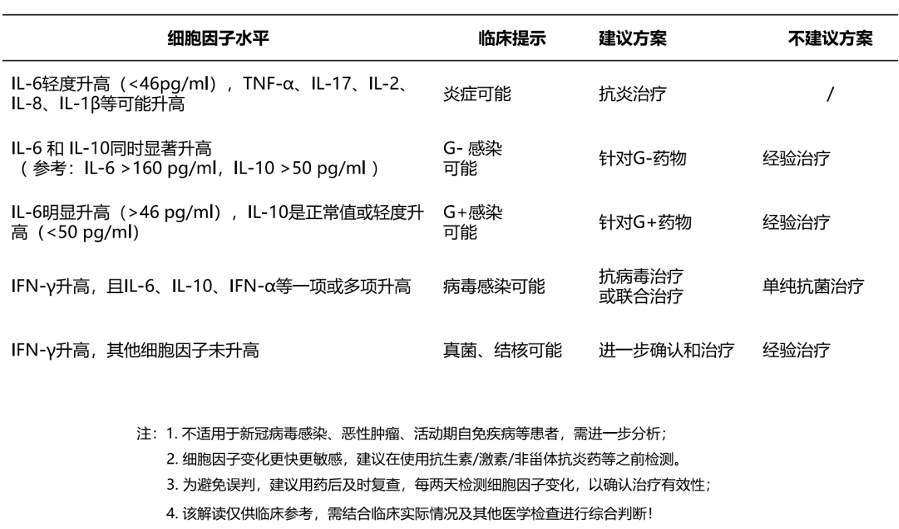
3. Early warning of cytokine storm
During the period of COVID-19, many critically ill patients suffered from uncontrolled release of cytokines such as IL-6, IL-8, TNF-α, IFN-γ, which led to coagulation storm, thrombosis, myocardial infarction and pulmonary embolism, leading to respiratory failure, organ failure and even death.
Although IL-6 is the key cytokine for everyone at present, it should not be the only one. Cytokines is a huge regulatory network, which is coordinated with each other, constantly changing dynamically and changing with the course of disease.
Therefore, it is suggested that patients at risk of cytokine storm should be jointly tested for cytokines during admission and hospitalization.
4. Assess the inflammation and immune status of the body.
Severe patients may have three inflammatory/immune states: SIRS (Systemic Inflammatory Response Syndrome), CARS (Antagonistic Inflammatory Response Syndrome) and MARS (Mixed Antagonistic Response Syndrome).
When infection or other reasons lead to the imbalance of inflammatory response, if the levels of a large number of proinflammatory factors such as IL-1β, IL-6, IL-8, IL-12, IFN-γ, IFN-α and TNF-α are greatly increased, there is a risk of systemic inflammatory response syndrome -SIRS, and the inflammatory response of the body is strong at this time, so it is recommended to give priority to anti-inflammatory treatment; If the endogenous anti-inflammatory reaction is too strong, the anti-inflammatory factors such as IL-4 and IL-10 will be greatly increased, which indicates the risk of CARS. At this time, the immune function of the body is weak, and it is suggested to strengthen the immune treatment. If both pro-inflammatory factors and anti-inflammatory factors increase significantly, it suggests that the body is a mixed antagonistic response syndrome, suggesting that the body has a strong inflammatory response and low immune function, and it is suggested to carry out anti-inflammatory combined with immune enhancement therapy.
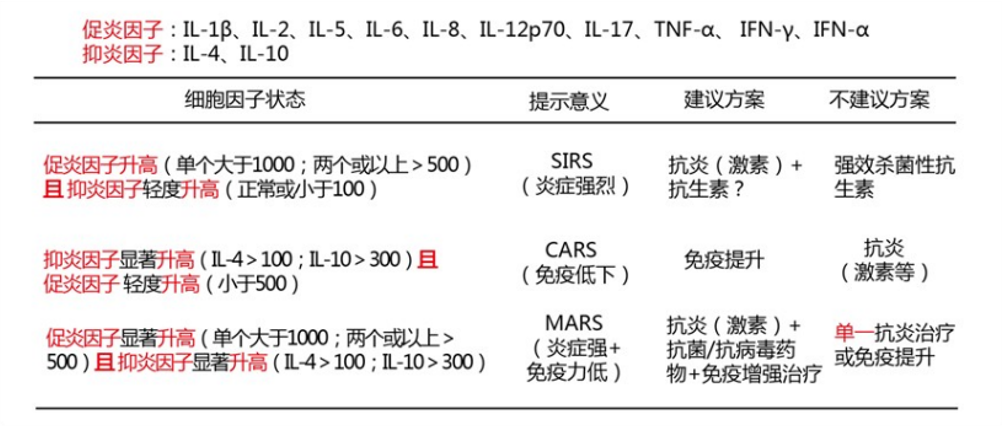
5. Cytokines and Tumor
Cytokines are the key proteins of signal transmission in tumor microenvironment (TME), which have pleiotropic effects. In terms of anti-tumor, interferon and TGF-β can directly inhibit the growth of tumor cells, while IFN-γ, IL-2, IL-12 and IL-15 can enhance the cytotoxic activity of lymphocytes or bone marrow cells, thus inhibiting cell growth; In promoting tumor, TGF-β, TNF, IL-1β, CXCL12, etc. can promote the survival and proliferation of tumor cells; TNF, IL-6, etc. can cause the disorder of cytokine regulation and promote the occurrence of tumor inflammation; IL-10, IL-4, TGF-β, etc. are immunosuppressed; TNF, IL-6 and various chemokines can also promote angiogenesis.
Studies have confirmed that IL-6, IL-10 and IL-12 are slightly increased, while IL-2, TNF-α and IFN-γ are significantly decreased, suggesting that there may be early tumor microenvironment progress. Early warning of the occurrence of adverse reaction cytokine release syndrome (CRS) caused by PD-1 therapy /CAR-T therapy.
6. Cytokines and Autoimmunity
Hemophagocytic syndrome (HLH):HLH may be caused by persistent antigen stimulation caused by autoimmune diseases or malignant tumors, with high mortality. IL-2R is one of the diagnostic criteria (from China Expert Consensus on Diagnosis and Treatment of Hemophagocytic Syndrome). In addition, the slight increase of IFN-γ, IL-10 and IL-6 can also distinguish HLH from infection, which is helpful for the treatment of HLH patients.
Systemic lupus erythematosus (SLE): As a chronic autoimmune disease, SLE will affect many organ systems, including but not limited to skin, joints and kidneys. Cytokines in active SLE patients, including IL-8, IL-18, IL-6 and IFN-α, were significantly higher than those in inactive SLE patients. Especially, IL-6 and IL-8 showed better sensitivity and specificity than traditional C3, C4 and Anti-dsDNA.
Henoch-Schonlein Purpura (HSP): A large number of studies show that inflammatory cytokines in HSP patients are out of balance, mainly IL-6, IL-8 and TNF-α. When the cutoff value of IL-6 is set to 7 pg/mL, the sensitivity and specificity can reach 78.0% and 80.5%. The change of IL-8 will be greater, which is 2-10 times of the baseline level of healthy people.
7, cytokines and asthma, allergic diseases and lung diseases.
Generally speaking, children’s allergic diseases such as asthma and allergic rhinitis are mainly mediated by humoral immunity (IgE-mediated type I allergy). IL-4 and IL-5 can promote the secretion of IgE antibodies, aggravate allergic diseases, monitor the levels of IL-4 and other proinflammatory factors, and evaluate the condition and efficacy.
In addition, pro-inflammatory cytokines such as IL-6, IL-8 and TNF-α can promote the progress of airway inflammation such as chronic obstructive pulmonary disease (COPD) and pneumonia, and evaluate the changes of cytokine levels, so as to evaluate the disease progress and drug efficacy monitoring of the above diseases.
8. Cytokines and Reproductive Medicine
Studies have proved that Th1 cytokines are significantly increased and Th2 cytokines are decreased in patients with unexplained recurrent abortion. It has also been reported in the literature that the significant increase of IL-22 concentration may be related to unexplained recurrent abortion.

Advantages and disadvantages of mainstream detection methods for cytokine reagents
1, chemiluminescence method
Advantages: The method is mature and stable in technology, high in sensitivity and wide in linear range, and can efficiently complete single detection in a short time.
Disadvantages: it is impossible to carry out multi-project joint inspection and the sample demand is large, which makes it unable to cope with the large sample size test.
2. Flow fluorescence method
Advantages: As a relatively new detection method, flow fluorescence method stands out for its advantages of realizing multi-item joint inspection with small sample size, especially in large sample size testing, which saves time and cost.
Disadvantages: It may not be as sensitive as the light-emitting platform, and it is difficult to solve the interference problem that may be introduced in the process of multi-joint inspection, which affects the accuracy of its detection to some extent.
3. Enzyme-linked immunosorbent assay
Advantages: The method is mature and stable, with high sensitivity and good stability.
Disadvantages: the reaction time is relatively long, the linear range is narrow, and the detection efficiency is low, so it is more used in scientific research.
Market situation and current situation sharing of cytokine reagents
1. The domestic heat is higher than that of foreign countries.
Through investigation, we found that, for cytokine projects, except IL-6, foreign manufacturers are more respected, and almost no other manufacturers have obtained certificates in China or even CE. At present, only Siemens has obtained the registration certificates for six projects, namely IL-1β, IL-2R, IL-6, IL-8, IL-10 and TNF-α, in China, which is regarded as an early cytokine project company that entered the China market.
The joint inspection of cytokine combination project seems to be a unique project in China, and it is difficult for us to find similar packaged tests in other countries.
From the actual clinical point of view, COVID-19 and sepsis have confirmed the significance of IL-6 detection, and hemophagocytic syndrome has clarified the value of IL-2R detection. However, for other cytokine detection, although everyone is advocating the clinical significance of each index, there is no more recognized expert consensus to explain it. It can only be said that the market prospect is there, but more clinical practice is needed to confirm it.
At present, there are mainly two factions in the detection of cytokines in China, such as the magnetic particle light-emitting platform of Hot Scene Bio, which has obtained the registration certificates of 13 indicators, namely TNF-α, IFN-γ, IL-1β, IL-2, IL-2R, IL-4, IL-5, IL-6, IL-8, IL-10 and IL. At present, the flow fluorescence platform made by Hu Manzhi is generally combined with 12 items, namely TNF-α, IFN-α, IFN-γ, IL-1β, IL-2, IL-4, IL-5, IL-6, IL-8, IL-10, IL-12p70 and IL-11.
2. Although there are international standards for each project, the testing situation of each manufacturer is not uniform.
Due to the lack of foreign reagents, it seems difficult to maintain the consistency of test results except IL-6. Although almost every project has international standards, from the data of clinical tests, the test results of various manufacturers deviate seriously, and it is difficult to judge which manufacturer’s test value is more accurate. It may be inferred that the traceability chain of each manufacturer is not particularly strict.
We know that most cytokines can’t be stored stably at room temperature, so the general calibrators are in the form of freeze-drying, which may be due to the loss during freeze-drying, or the interference of composite quality control such as flow platform, or the matrix effect introduced in the dilution process of international standards, which makes the test results of reagents difficult to be unified and leads to confusion in clinical judgment.
Market prospect of cytokine detection reagents
Although we have mentioned the problem that various cytokines form a complex network of communication and restriction between cells, there is no disease-specific guidance for many indicators at present, and it is difficult to unify the test results among manufacturers, but on the other hand, it is a huge opportunity for reagent manufacturers. Why do you say that?
First of all, the broad indications of detection indicators mean that cytokine items can be detected in various departments, with a large volume; Moreover, there are not many manufacturers in this testing field, and compared with conventional testing items, the homogenization is not serious and the market prospect is relatively broad; Moreover, the difference in the test results of manufacturers will inevitably lead to the emergence of benchmark enterprises in this field, so many enterprises can establish their own brand image through this product; It is believed that with the further implementation of the consensus of experts in various fields and the gradual maturity of emerging technologies such as flow fluorescence and single molecule detection, cytokine detection will surely be a red sea.
Today’s sharing is here, I hope it will inspire you. (For more information about cytokine detection reagents, please search the official website of HUMAN Zhizhi and click to inquire.)
About Hu manzhizao
Beijing Human Zhizao Technology Co., Ltd. is a medical technology innovation company integrating R&D, production and sales. With years of experience in materials science, in vitro diagnosis technology and marketing, based on the core of multi-flow fluorescence technology, the company is committed to providing fully automatic multi-flow fluorescence detection platform and supporting reagents with competitive advantages for clinical customers, and has built a "new ecology" for ultra-high-speed immunodiagnosis, focusing on major immune diseases, intractable diseases and rare diseases.
关于作者